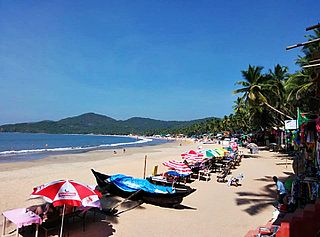
The Lockheed S-3 Viking is a four-seat, twin-engine turbofan-powered jet aircraft that was used by the U.S. Navy primarily for anti-submarine warfare. In the late 1990s, the S-3B's mission focus shifted to surface warfare and aerial refueling. The Viking also provided electronic warfare and surface surveillance capabilities to the carrier battle group. A carrier-based, subsonic, all-weather, multi-mission aircraft with long range; it carried automated weapon systems, and was capable of extended missions with in-flight refueling. Because of the characteristic sound of the Viking's engines, it was nicknamed the "Hoover" after the vacuum cleaner brand.
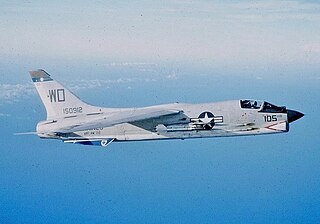
The Vought F-8 Crusader is a single-engine, supersonic, carrier-based air superiority jet aircraft built by Vought for the United States Navy and Marine Corps, and for the French Navy. The first F-8 prototype was ready for flight in February 1955. The F-8 served principally in the Vietnam War. The Crusader was the last American fighter with guns as the primary weapon, earning it the title "The Last of the Gunfighters".

The Dassault Étendard IV is a subsonic carrier-borne strike fighter aircraft, which entered service with the French Navy in 1962. It served as the basis for the more advanced Dassault-Breguet Super Étendard. During the 1970s, it had been intended to replace the Étendard IV with a navalised version of the SEPECAT Jaguar, designated as the Jaguar M. However, development of the Jaguar M was cancelled and shortly after replaced by the Super Étendard. The Étendard IV was progressively withdrawn during the 1980s and finally retired from service with its sole operator in 1991.

The Dassault-Breguet Super Étendard is a French carrier-borne strike fighter aircraft designed by Dassault-Breguet for service with the French Navy.

The Martin P5M Marlin, built by the Glenn L. Martin Company of Middle River, Maryland, was a twin piston-engined flying boat that entered service in 1951, and served into the late 1960s with the United States Navy performing naval patrols. It also served with the United States Coast Guard and the French Navy. 285 were produced overall.
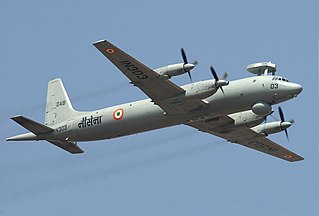
The Ilyushin Il-38 "Dolphin" is a maritime patrol aircraft and anti-submarine warfare aircraft designed in the Soviet Union. It was a development of the Ilyushin Il-18 turboprop transport.

The Breguet Br.1150 Atlantic is a long-range maritime patrol aircraft designed and manufactured by Breguet Aviation. Introduced to service in 1965, it has been operated by several NATO countries, commonly performing maritime roles such as reconnaissance and anti-submarine warfare. The Atlantic is also capable of carrying air-to-ground munitions to perform ground-attack missions; a small number of aircraft were also equipped to perform ELINT operations. An updated version, the Atlantique 2 or ATL2, was produced by Dassault Aviation for the French Navy in the 1980s. Other operators of the Atlantic have included the German Navy, the Italian Air Force, the Pakistan Navy, and the Royal Netherlands Navy.
The Breguet Br.960 Vultur was a French prototype carrier-based attack aircraft that first flew on 3 August 1951. Only two examples were built, but the work done on them later proved useful in the development of the Breguet Alizé anti-submarine warfare aircraft.

The Aichi E13A was a long-range reconnaissance seaplane used by the Imperial Japanese Navy (IJN) from 1941 to 1945. Numerically the most important floatplane of the IJN, it could carry a crew of three and a bombload of 250 kg (550 lb). The Navy designation was "Navy Type Zero Reconnaissance Seaplane" (零式水上偵察機).
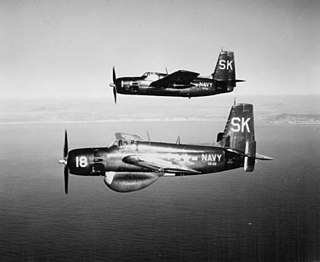
The Grumman AF Guardian was the first purpose-built anti-submarine warfare (ASW) carrier-based aircraft to enter service with the United States Navy. It consisted of two airframes, one for detection gear, the other for weapons. The Guardian remained in service until August 1955, when it was replaced by the twin-engined Grumman S-2 Tracker. The Guardian was the largest single-engine piston-powered carrier aircraft ever to see service.

The Grumman XTSF was a proposed twin-engine torpedo scout aircraft, designed by Grumman for the United States Navy towards the end of World War II. Based on the design of the Grumman F7F Tigercat fighter, enlarged and with the addition of a bomb bay, the XTSF was deemed too large for carrier operations, and the project was cancelled before any aircraft were built. Instead, the Navy chose to order the single-engine XTB3F, which became the successful AF Guardian.
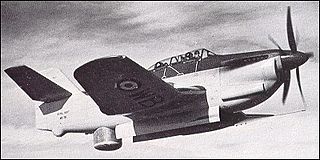
The Blackburn B-54 and B-88 were prototype carrier-borne anti-submarine warfare aircraft of the immediate post-Second World War era developed for the Royal Navy's Fleet Air Arm (FAA). They shared a conventional monoplane design with a mid-mounted inverted-gull wing and tricycle undercarriage. The pilot and observer sat in tandem under a long canopy atop the fuselage. The B-54 had a piston engine and the B-88 a gas turbine driving large contra-rotating propellers. The radar scanner was mounted in a retractable radome in the rear fuselage, behind a long internal weapons bay. The program was cancelled in favour of the Fairey Gannet aircraft.

The Clemenceau-class aircraft carriers are a pair of aircraft carriers which served in the French Navy from 1961 until 2000. From 2000 until 2017 one served with the Brazilian Navy as São Paulo. The Clemenceau class was France's first successful aircraft carrier design after World War II and was the backbone of the French Fleet for the duration of its forty years of service.

The Yokosuka B4Y,, carrier torpedo bomber was used by the Imperial Japanese Navy Air Service from 1936 to 1943. The B4Y replaced the Mitsubishi B2M2 and was the last biplane bomber used operationally by the Imperial Japanese Navy. The Allied reporting name was "Jean".

The Potez-CAMS 141 was a French long range reconnaissance flying boat of the late 1930s. Intended to equip the French Navy, only a single prototype was completed before the German invasion of France stopped production. That prototype did, however serve operationally from bases in French North Africa until scrapped in 1943.

The Breguet 730 was a French flying boat of the 1930s. Built to meet the requirements of the French Navy, it was ordered into production but no aircraft were delivered before France surrendered to Germany in June 1940. Four remaining incomplete airframes were completed after the end of World War II, serving with the French Navy until 1954.

The Fouga Zéphyr was a 1950s French two-seat carrier-capable jet trainer for the French Navy. It was developed from the land-based CM.170 Magister. It was replaced in 1994. Its function was taken over by the US Navy which is tasked to provide primary flight training.

The Levasseur PL.10 was a carrier-based reconnaissance aircraft developed in France in the late 1920s. It was a conventional, single-bay biplane along similar lines to Levasseur's contemporary designs for the French navy, including a watertight, boat-shaped fuselage, small underwing floats, and undercarriage that could be jettisoned in flight in order to improve the changes of a successful ditching.
The Breguet 790 Nautilus was a prototype French three-seat coastal patrol flying-boat designed and built by Breguet Aviation to meet a requirement from the French navy.

The Breguet 460 Vultur was a French bomber of the 1930s. Few of these twin-engined monoplanes and its variant, the Breguet 462 Vultur, were built. At least one Breguet 460 was sold to the Spanish Republican Air Force during the Spanish Civil War.

















